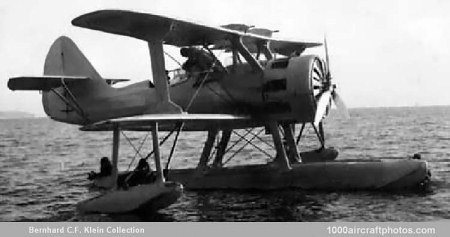Simple metal airframe with the biplane wings folding to rear, with central float. Fuselage welded from steel tubes, with fabric covering apart from light-alloy engine cowl (with plated front with air cooling apertures ahead of cylinders) and front upper decking. Dural wings with two main spars and Warren-truss ribs, again with fabric covering, and hollow I-struts. Duralumin floats with flush riveting. Ailerons on upper wings, pneumatic landing flaps on lower. Power plant was a 700 hp M-25 engine
Tandem cockpits for pilot and observer/radio/gunner, with dual flight controls. Two windshields or, more often, glazed superstructure around front of large rear cockpit. Normally equipped with two forward-firing ShKAS in fairings above upper center section with magazines under dural wing-skin covers, single ShKAS aimed by gunner, folding down into recess ahead of fin, and lower-wing racks for two FAB-100 bombs.
First flight was probably in April 1936, and deliveries started in 1937. Considerable problems were encountered with seaworthiness, structural deflection afloat and during catapult shots, and also with engine overheating. Though production continued (at least 300 being built by 1940), the release for service use in 1937, with service designation KOR-1 was only partial. Most were used for shoreline patrol and customs duties.
Beriev strove to rectify defects, and in 1939 obtained full release for the KOR-1 for naval aviation use without armament and with normal take offs only. In 1939 a landplane version, with no separate designation, was also flown, a number were converted from seaplanes. Though this was ungainly, it was free from structural restrictions. Both sea and land versions were still in service in June 41, and the latter was pressed into use as a close-support and attack aircraft on the Romanian and Besarabian fronts.
Span: 36 ft 1 in (11.00 m)
Length: 28 ft 5.5 in (8.67 m), landplane 23 ft 7.5 in (7.20 m)
Wing area: 315.4 sq.ft (29.3 sq.m)
Weight empty: 3,968 lb (1,800 kg)
Loaded weight: 5,480 lb (2,686 kg)
Max speed: 172 mph (277 kmh) at 6,560 ft (2,000 m)
Cruise speed: 75 mph (120 kmh) at 29,527 ft (9,000 m)
Landing speed: 37 mph (60 kmh)
Climb: to 3,281 ft (1,000 m) 3 min 12 sec
Service ceiling: 21,650 ft (6,600 m)
Range: 621 mls (1,000 km)
